Thick wheat noodles in a savory black bean sauce with pork belly, onions, cabbage, zucchini, and cucumbers. This quick and easy Jajangmyeon is restaurant quality, saves you money on takeout and is great for the whole family to enjoy!
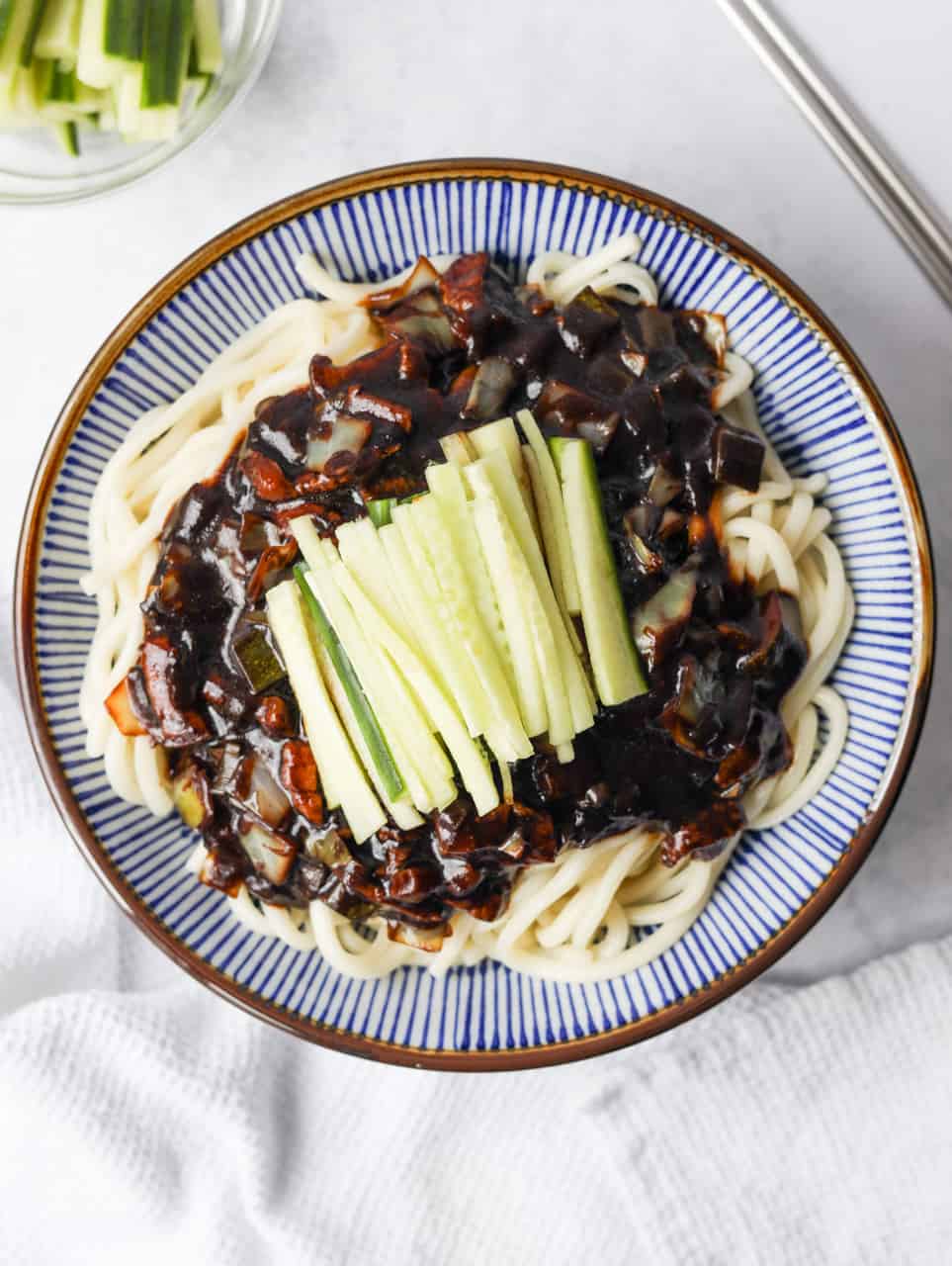
Jump to:
What is Jajangmyeon?
Jajangmyeon (자장면), aka jjajangmyeon, is a Korean-Chinese noodle dish made of Korean black bean paste sauce with pork belly, zucchini, potatoes, cabbage, and onions.
These black bean noodles are often served Tangsuyuk (Korean sweet and sour pork) with fresh cucumber or pickled daikon radish to balance the salty flavors. But I share many other pairing suggestions below.
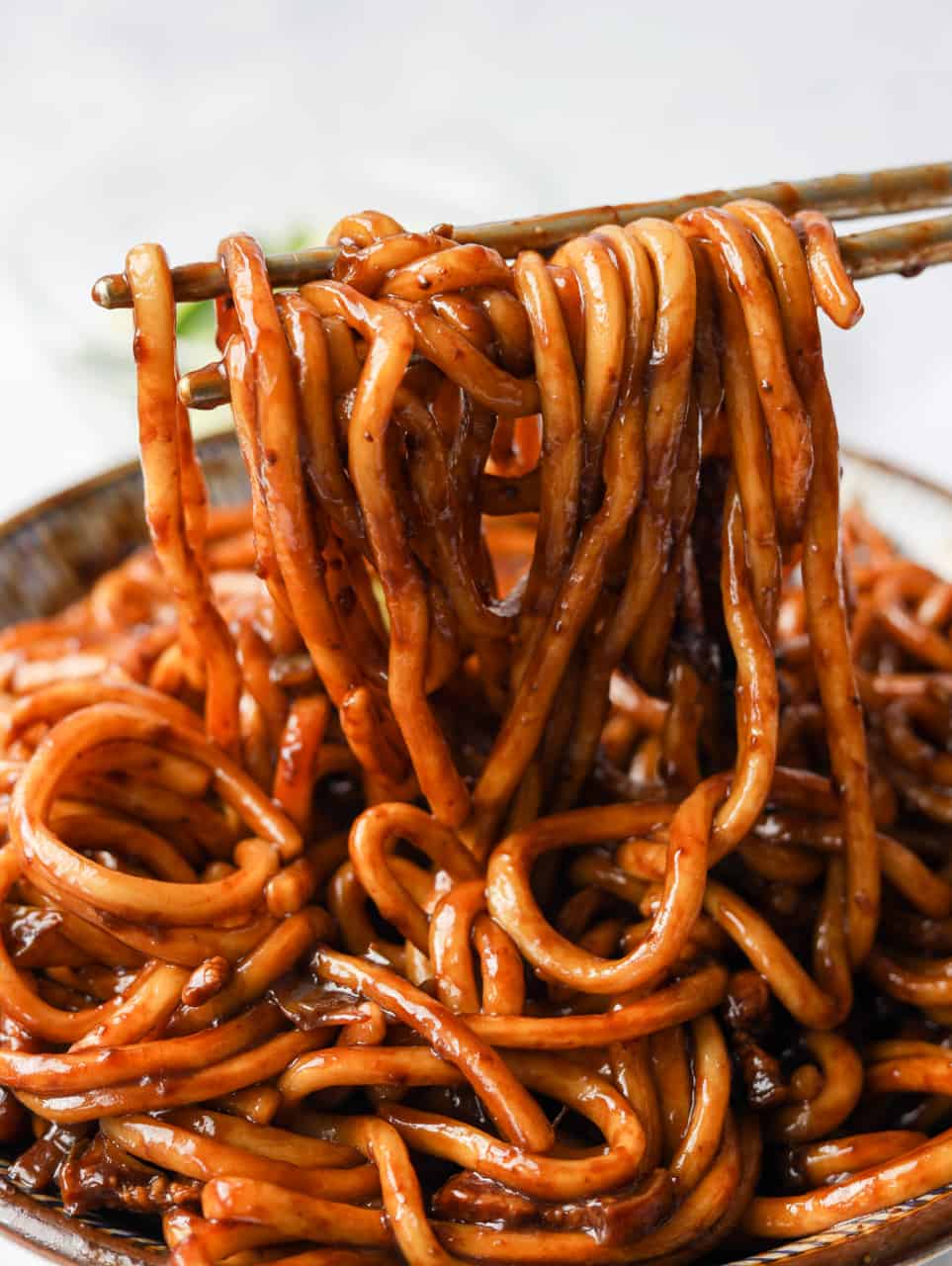
The soybean paste is called Chunjang and it's made of fermented black beans, caramel and flour. It was created by Chinese immigrants in Korea and used in Korean cuisine. Chunjang is slightly different in taste from Chinese black bean paste and Koreans swear by it for this dish.
You'll find this main dish served at many Korean restaurants and featured in many K-dramas or mukbangs as comfort food. In South Korea, this popular Korean noodle dish is eaten on a special day like on graduation, birthdays or a special occasion.
Ingredients & Substitutes
Please scroll down to below full recipe card for exact measurements.

- Fresh Korean wheat noodles: I recommend using fresh wheat noodles or substitute with udon noodles or dry wheat noodles and follow package directions to prepare them.
- Pork belly: or feel free to substitute with chicken, beef, pork loin or ground meat. I would avoid using ground turkey as it emits a taste that doesn't compliment the sauce. For a vegetarian version, substitute with diced extra-firm tofu.
- Korean-style black bean paste, aka Chunjang: If you can't find the Korean version, as a last resort substitute with Chinese black bean paste.
- Neutral oil: like avocado oil, sunflower oil, grapeseed oil, peanut oil, vegetable oil or canola oil. Avoid olive oil, coconut oil or any heavy scented oils.
- Onion
- Green cabbage: avoid using napa cabbage as it's too watery
- Zucchini: green or yellow squash can both work.
- Green onion
- Oyster sauce: or substitute with vegetarian stir fry sauce if you don't like oysters. If you're gluten-free: substitute with a gluten-free version.
- Cucumber: optional garnish
Cornstarch slurry
- Cold water
- Cornstarch or potato starch: to help thicken the sauce
- White Granulated Sugar
Note: Korean or Asian grocery stores will carry these ingredients.
Expert Tips
- Use a non-stick pan to prevent the sauce from sticking and to make life easier!
- Fry the black bean sauce in oil. This makes the sauce taste less bitter and more smooth.
- Don't skimp on the oil when frying the paste! You'll need enough to make the black bean paste glossy and to prevent it from sticking to the pan.
- Allow the pork to fry so some of the oil can render out to create a more flavorful sauce!
- Thicken the sauce by simmering the sauce uncovered. The sauce should be thickened before you add the noodles.
- Boil noodles after sauce is made. We want to boil the noodles after the sauce is complete to prevent the cooked noodles from becoming soggy if you were to cook them before the sauce.
- Boil the noodles until al dente and make sure to taste them! You don't want overcooked noodles for this recipe.
- Don't rinse the noodles with cold water! This removes the wheat flavor in the noodles.
- Strain the noodles well as any residual water will make the noodles soggy and dilute the sauce.
- Enjoy noodles immediately! With time, the noodles will become soggy in the sauce.
Instructions
Below are step-by-step instructions on how to make jajangmyeon:
Make Cornstarch Slurry and Fry Bean Paste
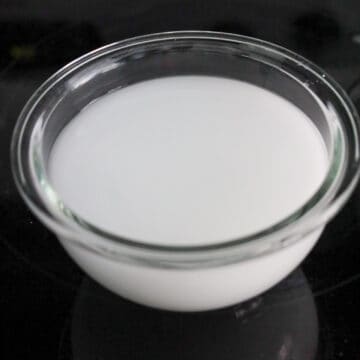
In a small bowl, combine sugar, cornstarch, and water. Mix well and set aside.
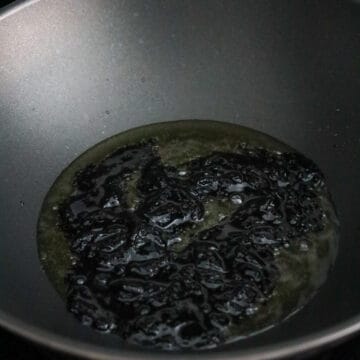
In a large pan on medium heat, add vegetable oil or any neutral oil and fry black bean paste for 2-3 minutes stirring constantly. Pour black bean paste and oil into a separate bowl, leaving about 1 tablespoon of oil in the pan. Strain and discard the excess oil and reserve the black bean paste.
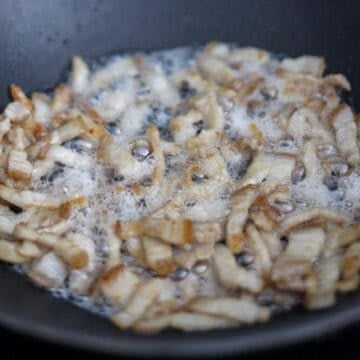
Fry pork belly in the same oiled pan until cooked and browned on edges. This pork fat will make the sauce extra delicious so don't pour it out.
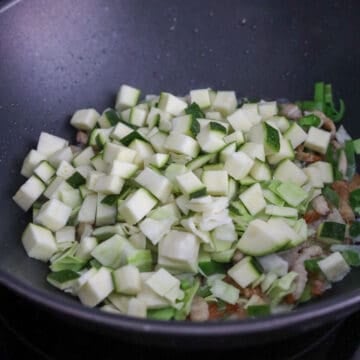
Add onions and green onions and fry until softened. Then add in zucchini and cabbage and fry until softened.
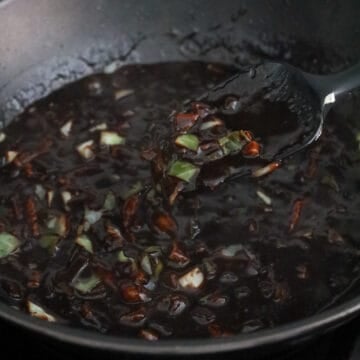
Add cooked pork and black bean paste. Mix well. Give your cornstarch slurry another mix and pour it into pan and mix well. Simmer the black sauce until it’s thickened.
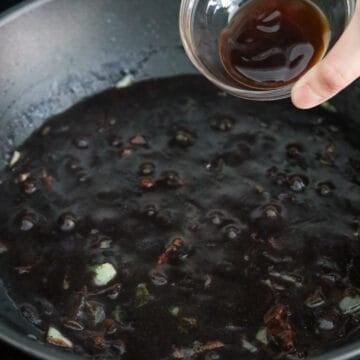
Season sauce with oyster sauce.
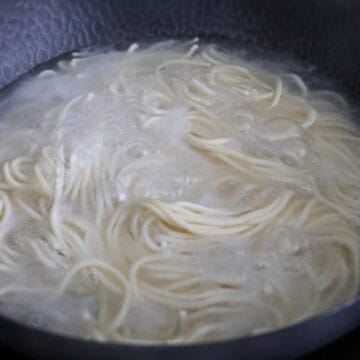
In a large pot filled with water, bring to a boil and boil the noodles on high heat uncovered for 3-4 minutes until al dente. Strain noodles immediately. Do not rinse off with cold water.
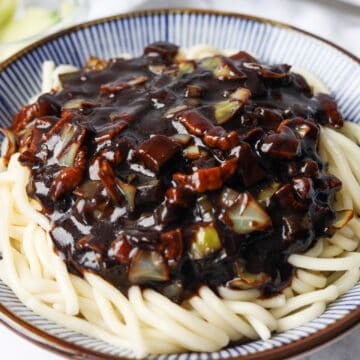
Transfer cooked noodles to a large serving bowl. Pour the sauce over the noodles. Garnish with julienned cucumber and mix to enjoy!
Storage
- Leftovers will last up to 4 days stored in an airtight container in the refrigerator. To reheat, microwave for 2-3 minutes until hot or reheat in a pan on medium heat.
- Freezer-friendly? It's not recommended to freeze jajangmyeon because the freezer air will make the vegetables mushy.
Pairing Suggestions
Jajangmyeon serves well with Tangsuyuk (sweet and sour pork) and pickled daikon radish or with Korean side dishes like:
FAQ
You can make the sauce in advance as per the recipe instructions and store the sauce alone in an airtight container in the fridge for up to 4 days. Reheat the sauce in a pan on medium heat or microwave for 2-3 minutes. When ready to enjoy, boil and strain the noodles and add them to the reheated sauce.
They are thick, long, white and powdered with starch. They look like the image below.
Yes, feel free to add any crunchy vegetables with a low-water content like carrots or potatoes.
Other recipes you may like
📖 Recipe
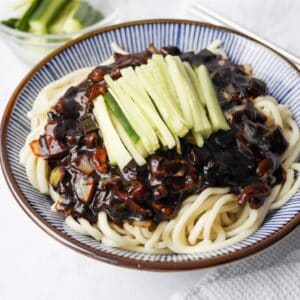
Quick & Easy Jajangmyeon (Korean Black Bean Noodles)
Ingredients
- 1.20 lbs thick wheat noodles fresh kind recommended or sub with udon noodles
- 0.65 lbs pork belly chopped into smaller pieces
- 1 small onion finely chopped
- 1 cup green cabbage chopped
- 1 cup zucchini diced
- 2 green onion finely chopped
- ⅓ cup Korean roasted black bean paste aka Chunjang
- 3 tablespoon vegetable oil any neutral oil
- 1 tablespoon oyster sauce or sub with vegetarian stir fry sauce
Cornstarch slurry:
- 2 cups water cold
- 2 tablespoon cornstarch or sub with potato starch
- 2 tablespoon white granulated sugar
Garnish:
- ¾ cup cucumber thinly sliced for garnish
Instructions
- In a small bowl, combine sugar, cornstarch, and water. Mix well and set aside.
- In a large pan on medium heat, add vegetable oil or any neutral oil and fry black bean paste for 2-3 minutes stirring constantly. Pour black bean paste and oil into a separate bowl, leaving about 1 tablespoon of oil in the pan. Strain and discard the excess oil and reserve the black bean paste.
- Fry pork belly in the same oiled pan until cooked and browned on edges. This pork fat will make the sauce extra delicious so don't pour it out.
- Add onions and green onions and fry until softened. Then add in zucchini and cabbage and fry until softened.
- Add cooked pork and black bean paste. Mix well. Give your cornstarch slurry another mix and pour it into pan and mix well. Simmer the black sauce until it’s thickened.
- Season sauce with oyster sauce.
- In a large pot filled with water, bring to a boil and boil the noodles on high heat uncovered for 3-4 minutes until al dente. Strain noodles immediately. Do not rinse off with cold water.
- Transfer cooked noodles to a large serving bowl. Pour the sauce over the noodles. Garnish with julienned cucumber and mix to enjoy!


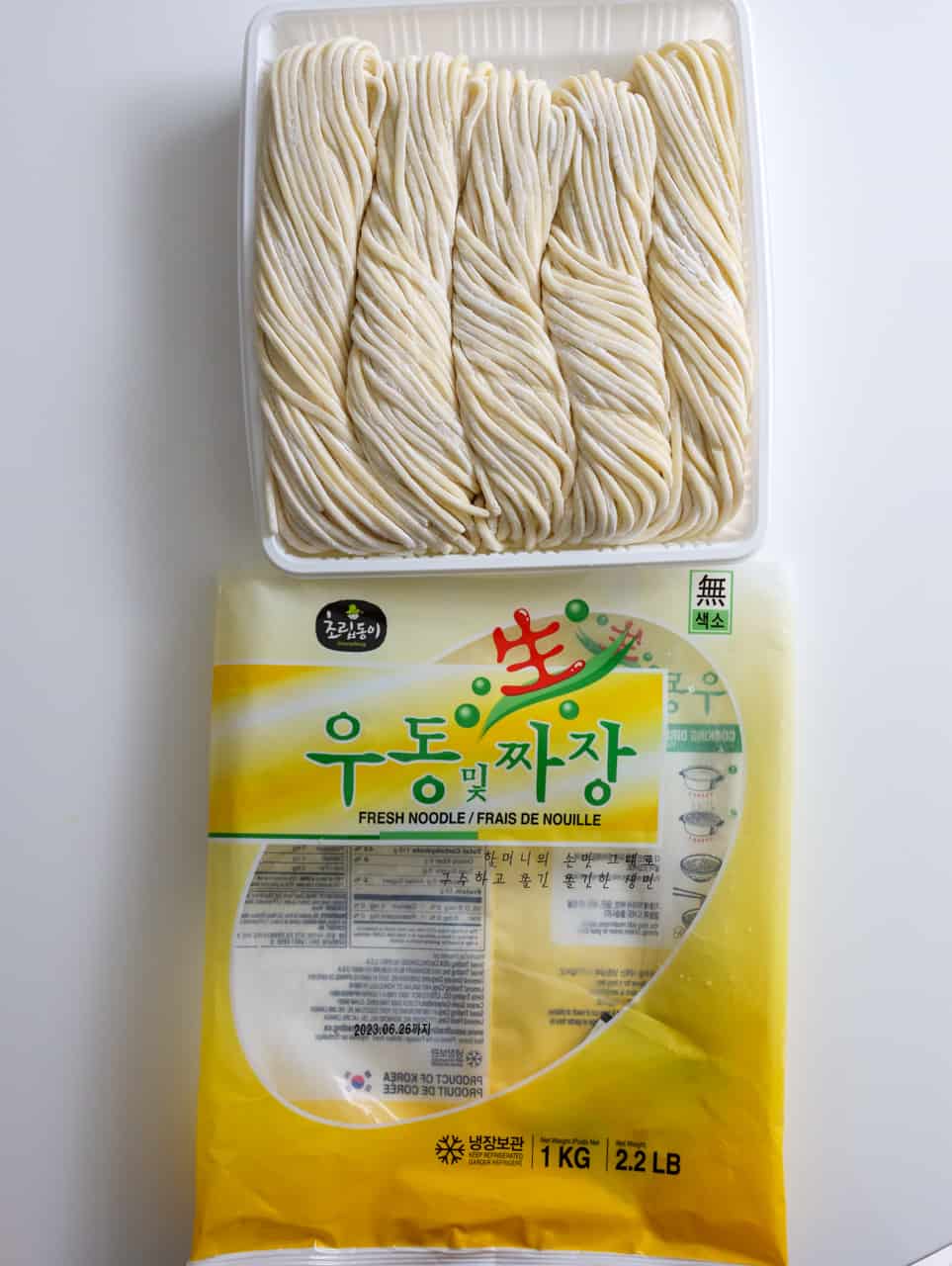

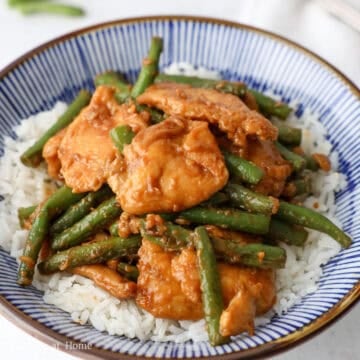
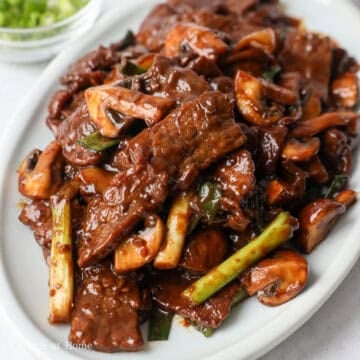
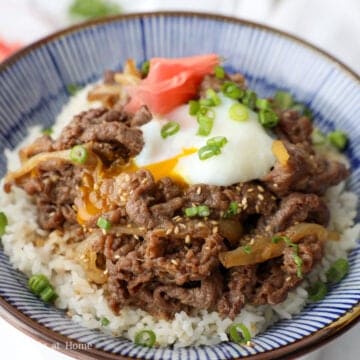
Xp
Just a question, can you freeze the sauce without the vegetables?
Christie Lai
Yes, that would work! A fine sieve will help strain out the vegetables so you're left with the sauce to freeze.
AliceK
This recipe looks wonderful! I do have a question about the pork belly. It isn't easy to find in my area. I know that it is the same cut that is used for making bacon. Could I substitute bacon, or just use a fatty piece of boneless pork?
christieathome
Thanks so much Alice! Yes, feel free to substitute with pork loin, pork shoulder or ground pork/beef.
Kathryn
Do you need to add cornstarch?
christieathome
Sorry for the delayed reply! Yes, it's needed to help thicken the sauce.
Kerrie
Thank you so much! You are a life-saver! Every single recipe for this says boil noodles per instructions on the package. My package doesn't have any english except for an ingredient sticker. Without your recipe I was going to have to check the noodles every minute until they were done. Thanks again!!
christieathome
Thank you so much for making my recipe Kerrie! Glad I could help with these instructions 🙂
Never Ending Journeys
What a delicious noodle dish! I like the idea of putting the black beans on top, too!
Heidi | The Frugal Girls
I really liked your idea to use chicken as the protein. That really allows the yummy flavors of your sauce to come through! 😋
Safia
Loved all the historical facts behind this recipe and your own feelings. The metric measurements helped massively as well as the tips. Thumbs up from me!!!
Christie Lai
Thanks so much for your kind words, Safia! So glad I could share the background and my personal experience with this dish 🙂 Also glad the metric conversion tool has been helpful.
Vivian Wan
Finally my determination to get all the ingredients did not fail me. Made this and it was a hit! I used pork belly instead of chicken and it was so delicious. Definitely satisfied my jajangmyeon craving
christieathome
Thanks so much for your kind review Vivian! I'm so glad you enjoyed this recipe and having it with pork belly is such a delicious decision! 🙂 Thanks again!
Josiah - DIY Thrill
These noodles look so delicious!
Molly
These noodles were SOOOO BOMB!!! I tried it and it was so easy to make too.